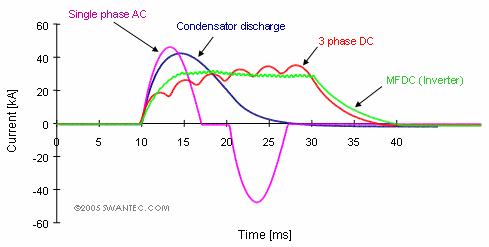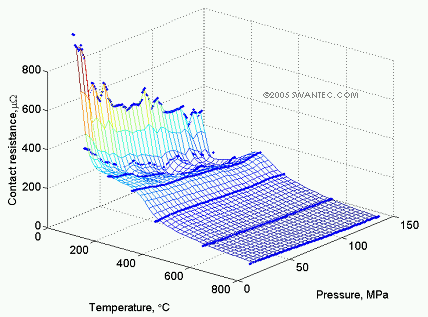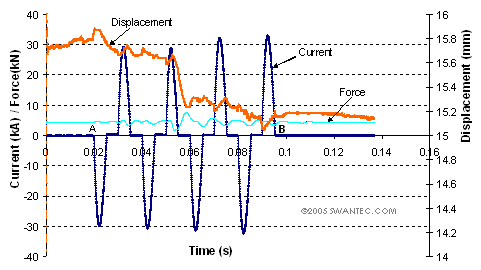Parameters in Resistance Welding
The principle of resistance welding is the Joule heating law where
the heat Q is generated depending on three basic factors as expressed
in the following formula:

where I is the current passing through the metal combination,
R is the resistance of the base metals and the contact interfaces,
and t is the duration/time of the current flow.
The principle seems simple. However, when it runs in an actual
welding process, there are numerous parameters, some researchers
had identified more than 100, to influence the results of a resistance
welding. In order to have a systematic understanding of the resistance
welding technology, we have carried out a lot of experimental tests
and summarized the most influential parameters into the following
eight types:
1) Welding current
The welding current is the most important parameter in resistance
welding which determines the heat generation by a power of square
as shown in the formula. The size of the weld nugget increases rapidly
with increasing welding current, but too high current will result
in expulsions and electrode deteriorations. The figure below shows
the typical types of the welding current applied in resistance welding
including the single phase alternating current (AC) that is still
the most used in production, the three phase direct current (DC),
the condensator discharge (CD), and the newly developed middle frequency
inverter DC. Usually the root mean square (RMS) values of the welding
current are used in the machine parameter settings and the process
controls. It is often the tedious job of the welding engineers to
find the optimized welding current and time for each individual
welding application.

2) Welding time
The heat generation is directly proportional to the welding time.
Due to the heat transfer from the weld zone to the base metals and
to the electrodes, as well as the heat loss from the free surfaces
to the surroundings, a minimum welding current as well as a minimum
welding time will be needed to make a weld. If the welding current
is too low, simply increasing the welding time alone will not produce
a weld. When the welding current is high enough, the size of the
weld nugget increases with increasing welding time until it reaches
a size similar to the electrode tip contact area. If the welding
time is prolonged, expulsion will occur or in the worst cases the
electrode may stick to the workpiece.
3) Welding force
The welding force influences the resistance welding process by its
effect on the contact resistance at the interfaces and on the contact
area due to deformation of materials. The workpieces must be compressed
with a certain force at the weld zone to enable the passage of the
current. If the welding force is too low, expulsion may occur immediately
after starting the welding current due to fact that the contact
resistance is too high, resulting in rapid heat generation. If the
welding force is high, the contact area will be large resulting
in low current density and low contact resistance that will reduce
heat generation and the size of weld nugget. In projection welding,
the welding force causes the collapse of the projection in the workpiece,
which changes the contact area and thereby the contact resistance
and the current density. It further influences the heat development
and the welding results.
4) Contact resistance
The contact resistance at the weld interface is the most influential
parameter related to materials. It however has highly dynamic interaction
with the process parameters. The figure below shows the measured
contact resistance of mild steel at different temperatures and different
pressures. It is noticed that the contact resistance generally decreases
with increasing temperature but has a local ridge around 300°C,
and it decreases almost proportionally with increasing pressure.
All metals have rough surfaces in micro scale. When the welding
force increases, the contact pressure increases thereby the real
contact area at the interface increases due to deformation of the
rough surface asperities. Therefore the contact resistance at the
interface decreases which reduces the heat generation and the size
of weld nugget. On the metal surfaces, there are also oxides, water
vapour, oil, dirt and other contaminants. When the temperature increases,
some of the surface contaminants (mainly water and oil based ones)
will be burned off in the first couple of cycles, and the metals
will also be softened at high temperatures. Thus the contact resistance
generally decreases with increasing temperature. Even though the
contact resistance has most significant influence only in the first
couple of cycles, it has a decisive influence on the heat distribution
due to the initial heat generation and distribution.

5) Materials properties
Nearly all material properties change with temperature which add
to the dynamics of the resistance welding process. The resistivity
of material influences the heat generation. The thermal conductivity
and the heat capacity influence the heat transfer. In metals such
as silver and copper with low resistivity and high thermal conductivity,
little heat is generated even with high welding current and also
quickly transferred away. They are rather difficult to weld with
resistance welding. On the other hand, they can be good materials
for electrodes. When dissimilar metals are welded, more heat will
be generated in the metal with higher resistivity. This should be
considered when designing the weld parts in projection welding and
selecting the forms of the electrodes in spot welding. Hardness
of material also influences the contact resistance. Harder metals
(with higher yield stress) will result in higher contact resistance
at the same welding force due to the rough surface asperities being
more difficult to deform, resulting in a smaller real contact area.
Electrode materials have also been used to influence the heat balance
in resistance welding, especially for joining light and non-ferrous
metals.
6) Surface coatings
Most surface coatings are applied for protection of corrosion or
as a substrate for further surface treatment. These surface coatings
often complicate the welding process. Special process parameter
adjustments have to be made according to individual types of the
surface coatings. Some surface coatings are introduced for facilitating
the welding of difficult material combinations. These surface coatings
are strategically selected to bring the heat balance to the weld
interface. Most of the surface coatings will be squeezed out during
welding, some will remain at the weld interface as a braze metal.
7) Geometry and dimensions
The geometry and dimensions of the electrodes and workpieces are
very important, since they influence the current density distribution
and thus the results of resistance welding. The geometry of electrodes
in spot welding controls the current density and the resulting size
of the weld nugget. Different thicknesses of metal sheets need different
welding currents and other process parameter settings. The design
of the local projection geometry of the workpieces is critical in
projection welding, which should be considered together with the
material properties especially when joining dissimilar metals. In
principle, the embossment or projection should be placed on the
material with the lower resistivity in order to get a better heat
balance at the weld interface.
8) Welding machine characteristics
The electrical and mechanical characteristics of the welding machine
have a significant influence on resistance welding processes. The
electrical characteristics include the dynamic reaction time of
welding current and the magnetic / inductive losses due to the size
of the welding window and the amount of magnetic materials in the
throat. The up-slope time of a welding machine can be very critical
in micro resistance welding as the total welding time is often extremely
short. The magnetic loss in spot welding is one of the important
factors to consider in process controls. The mechanical characteristics
include the speed and acceleration of the electrode follow-up as
well as the stiffness of the loading frame/arms. If the follow-up
of the electrode is too slow, expulsion may easily occur in projection
welding. The figure below shows measured process parameters in a
projection welding process, which include the dynamic curves of
the welding current, the welding force and the displacement of the
electrode, where the sharp movement corresponds to the collapse
of the projection in the workpiece.

|
